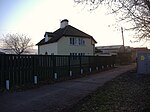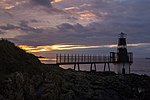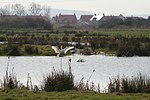Portishead, Somerset

Portishead ( PORT-iss-hed) is a town and civil parish in the North Somerset unitary authority area, in the county of Somerset, England. The town has a population of 27,000 and is located next to the Severn Estuary opposite Cardiff and Newport in Wales. The town is 8 miles (13 km) to the west of Bristol and 18 miles northeast of Weston-super-Mare. Portishead has a long history as a fishing port. As a Royal Manor it expanded rapidly during the early 19th century around the docks, with supporting transport infrastructure. A power station and chemical works were added in the 20th century, but the dock and industrial facilities have since closed and been redeveloped into a marina and residential areas. Portishead was also the telephone control centre used by British Telecom (BT) for non-direct dialled calls to maritime vessels, a service known as Portishead Radio. The headquarters of both Avon and Somerset Constabulary and Avon Fire and Rescue Service are in Portishead. Portishead Lifeboat Station is situated close to the marina. Run solely by local Royal National Lifeboat Institution (RNLI) volunteers, it serves the waters of the Severn estuary and inland waterways into the city of Bristol
Excerpt from the Wikipedia article Portishead, Somerset (License: CC BY-SA 3.0, Authors, Images).Portishead, Somerset
Old Mill Road,
Geographical coordinates (GPS) Address Nearby Places Show on map
Geographical coordinates (GPS)
| Latitude | Longitude |
|---|---|
| N 51.484 ° | E -2.7626 ° |
Address
Old Mill Road
Old Mill Road
BS20 7BY , West Hill
England, United Kingdom
Open on Google Maps








